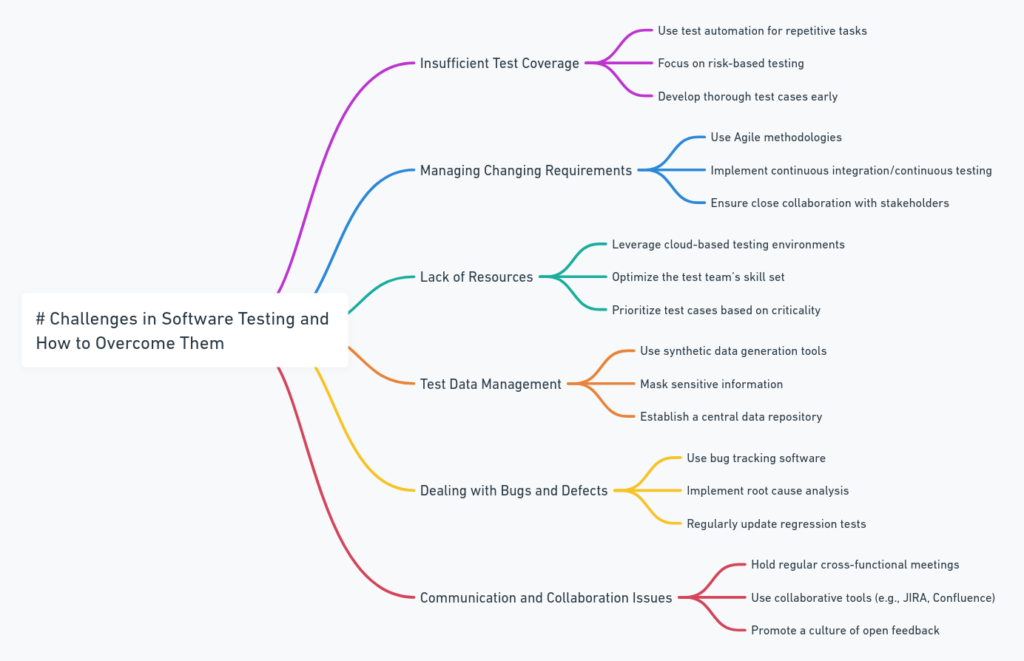Testing comes with particular problems that can affect the timeframe for development and the budget. This blog will explore the main challenges in software testing and offer ways to tackle them.
From costly upfront costs to security concerns for data to a dearth of highly skilled specialists These obstacles could make effective testing appear impossible for a lot of businesses.
Challenges in Software Testing and How to Overcome Them

1. High Upfront Costs of Software Testing
The Challenge
Software testing involves a significant investments in infrastructure, tools and experienced professionals and typically outcome in high initial expenses.
The expense of licensing specific testing equipment, setting up testing environments, and automation of repetitive work can prove daunting especially for smaller and mid-sized businesses.
In addition, the constant necessity of testing updates to ensure that the test is in line with changing software can also increase expenses.
Solution: Embrace Scalable and Cost-Effective Testing Strategies
To control these expensive initial costs, businesses can think about scalable testing solutions that can adapt to their requirements:
Utilize Cloud-based Testing tools
Cloud-based tools enable firms to pay only for the resources they utilize. This eliminates the need to invest in expensive infrastructure on premises Cloud platforms provide testing environments that are available on demand which reduces the cost of setting up and maintaining.
Make use of the Open Source Testing tools
Tools from the open source community like Selenium, JMeter, and Appium can be highly customized and can reduce the cost of licensing.
Although they might require expertise in technical aspects, a lot of open-source tools offer capabilities that are comparable to paid alternatives.
Implement Low-Code or No-Code Test Automation
Low-code or no-code automation tools let teams automate tests with minimal programming experience thus reducing time and effort for maintenance of scripts.
This can significantly reduce the costs of manual testing and updates to test.
2. Data Security and Privacy Concerns in Testing
The Challenge
Security of data is a major issue in testing software, particularly for companies that deal with sensitive customer data like healthcare, finance and commerce.
Testing environments usually require actual or simulated data as well as with production data in testing environments could expose companies to data security breaches and the risk of a breach in compliance.
Solution: Prioritize Data Privacy and Compliance Measures
Security concerns for data in test areas requires enough planning, and adhering of best practices in security accurate practices:
Mask sensitive or anonymize data
Data anonymization substitutes actual data for fake data that retains the same structure, however it lacks specific characteristics that identify. The use of anonymized data permits testers to mimic real user behavior, without risking sensitive data.
Utilize Synthetic Data
Synthetic data generation tools generate real-world test data that mirrors production data, but without any personal data. This method makes sure that sensitive data is secured and complies with the requirements of regulations like GDPR as well as HIPAA.
Establish secure test environments
Separating testing environment from the production as well as with access control for test data is essential. In addition, together encryption and secure procedures for handling data will ensure that confidential information is kept safe.
3. Shortage of Skilled Testing Professionals
The Challenge
The software testing industry is faced with an unsatisfactory supply of talent and the need for experienced automated engineers and testers oversupply.
Businesses struggle to find skilled professionals who have the right combination of technical knowledge and knowledge of the industry.
Additionally, the rapid development of testing technology including cloud-based testing and AI-driven testing can contribute an additional talent gap because it requires constant learning and constant adaptation.
Solution: Upskill Teams and Leverage AI-Driven Testing Tools
To meet the need for experienced testing professionals, companies could focus on training existing teams, and using tools that do not require as much expertise:
Invest in Training and Skill Development
Businesses can offer training courses to train their team members on the latest testing techniques and methodologies. Online courses, certificates, and workshops on automation tools as well as testing frameworks can help to close gaps in abilities gap.
Make use of AI-driven testing tools
AI-driven testing platforms help in creating testing, running, and maintaining test cases which eliminates the need for specialist knowledge.
These software tools generate tests automatically according to user behaviour as well as analyze changes in code and perform root analysis of causes for errors, easing the process of testing.
Test Outsourcing to specialist firms
Working with specialized QA firms can deliver quick access to experienced experts. This is especially beneficial when projects require specific skills, such as the testing of security and performance.
4. Managing Rapid Development Cycles and Frequent Code Changes
The Challenge
With the advent in Agile and DevOps methodologies, development times are becoming shorter and the code is updated more often.
This fast pace makes difficult to maintain a complete testing coverage, since teams are often struggling to keep pace with continual updates to code.
The frequent updates can lead to malfunctioning tests, a rise in maintenance and test bottlenecks.
Solution: Automate Regression Testing and Adopt Continuous Testing Practices
To handle testing in the rapidly changing testing cycles, groups require an effective testing plan that can keep up with ever-changing requirements:
Automated Regression Testing
Automating regression tests will ensure that the core functionality is checked every time code is changed and reduces the possibility of problems with regression.
This is essential to assure stability of the application without any manual intervention.
Implement Continuous Testing Practices
Incorporating testing into each stage of the development pipeline continuous testing helps teams identify issues earlier.
This practice facilitates faster feedback loops and ensures that testing is kept in up with the development process and makes it much easier to find and fix problems.
Use Test Automation Frameworks
Frameworks like CI/CD (Continuous Integration/Continuous Deployment) and BDD (Behavior-Driven Development) help teams streamline testing and integrate it into their workflows.
The frameworks warrant that testing automation is in sync with development, allowing quicker releases without sacrificing quality.
5. Ensuring Comprehensive Test Coverage
The Challenge
As software systems become increasingly complex, the task of achieving a comprehensive testing coverage becomes more difficult.
Testing should encompass a broad range of scenarios for users, edges scenarios, as well as the integration of third-party software. A lack of test coverage could result in undetected bugs and reduced user experience.
Solution: Use Data-Driven Testing and AI-Based Test Generation
To assure the most comprehensive and accurate test coverage, businesses may make use of AI-driven data and data-driven methods of testing:
Introduce Data-Driven Tests
Data-driven testing enables testers to test the same scenario with different kinds of data, giving more coverage for tests. This technique guarantees the test can be used to simulate different user inputs or scenarios. It makes it simpler to spot issues that would otherwise be overlooked.
Utilize AI-Based Test Generation
AI-powered tools can analyse codes, user behavior and usage patterns, to automatically create test cases. The tools assure that tests remain current to the latest software and will provide both standard and edge scenarios, offering a comprehensive overview.
Prioritize Tests using Risk-Based Testing
Testing based on risk involves identifying areas that are at risk of applications and prioritizing them during the test process. By focusing on the most important functions teams can assure maximum the coverage of tests where it is needed the most.
Book a Demo and experience ContextQA testing tool in action with a complimentary, no-obligation session tailored to your business needs.
Conclusion: Building a Resilient Testing Strategy
Software testing issues like the high cost of testing, data security concerns, as well as the lack of qualified professionals need a shrewd method to warrant the quality and effectiveness.
Through the use of scalable tools and practices for security as well as enhancing the talent of teams and automatizing testing processes, businesses are able to overcome these challenges and develop a robust testing strategy.
By combining the right combination of planning and technology Companies can assure that their software testing is effective, thorough and secure, even when they have to navigate the complexity of the modern development environment.
As AI-driven tools and automated processes continue to advance they'll play an increasingly important role in helping companies achieve their quality assurance objectives as they adapt to the changing requirements.
Also Read - Monkey Testing: Embracing the Unexpected with AI
We make it easy to get started with the ContextQA tool: Start Free Trial.
